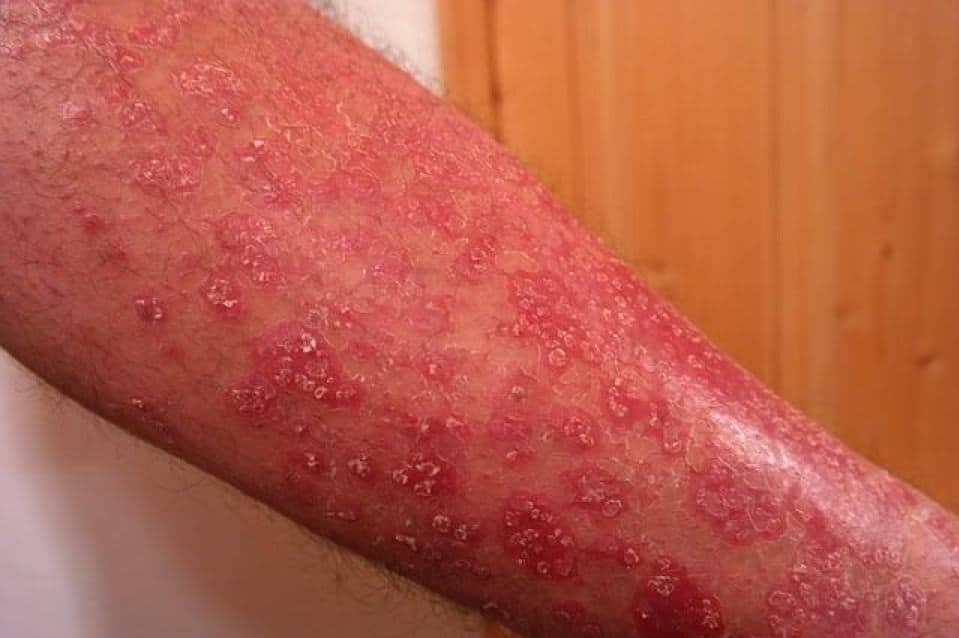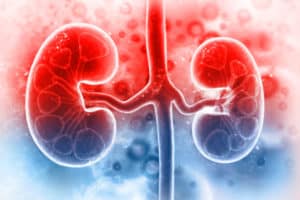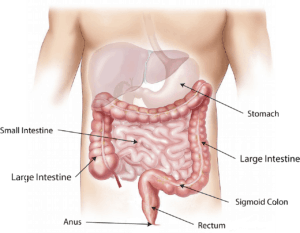What is psoriasis?
Psoriasis is an autoimmune disease of the skin that results in patches of thick red skin with silvery scales. An autoimmune disease happens when your body’s immune system attacks your own body instead of attacking bugs. The word ‘psoriasis’ is derived from the Greek word ‘psora’ which means ‘itching’.
In psoriasis, there is a rapid multiplication of skin cells (keratinocytes), much faster than normal leading to increased epidermal cell turnover. It is not a contagious disease and can not spread from person to person.
Pathophysiology
- Autoimmune: Hyperproliferation may be due to immunological response by T helper cell (a type of lymphocyte). Cytokines released by lymphocytes and Langerhans cells may further stimulate the inflammatory cells which cause epidermal cell turnover at an increased rate.
- Epithelial cells themselves produce cytokines that promote the proliferation of epithelial cells and attract lymphocytes.
- Genetic: Factors such as HLA B13, HLA B17, and HLA CW6 are associated.
Epidemiology
- Incidence: The prevalence of psoriasis is 2-3 % in the United States. About 7.4 million of the American population are affected by psoriasis. There is high-level concordance (70%) in identical twins.
- Sex: It occurs equally in both males and females.
- Age: Psoriasis appears in two peak ages, the first peak (early onset) occurs at 16-22 years of age and the second peak (late-onset) occurs in a person aged 57-60 years.
What are the causes of psoriasis?
Mostly psoriasis is an idiopathic disease, meaning it occurs without any cause under the influence of genetic association and environmental factors. There are certain triggering factors that give rise to this disease such as:
- Infection
- Injury to the skin
- Changes in climate (especially in cold temperature)
- Autoimmune reaction
- Medications like lithium, antimalarial drugs, beta-blockers, interferon alpha etc.
- Psychological stress
- Obesity
- Smoking
- Alcohol
- Genetic factors also play a vital role in the development of this disease

Types of psoriasis
- Plaque psoriasis: It is the most common type and also known as the psoriasis vulgaris. The lesions are red with a silvery top layer, scaly which bleeds on removal.
- Guttate psoriasis: Small teardrop shaped papular eruption occurs in the upper trunk and proximal extremities at an early age and commonly associated with streptococcal infections. Usually it resolves within two to three weeks without any treatment.
- Inverse psoriasis: It commonly occurs in major skin folds such as the axilla, gluteal cleft, and inguinal area. It is usually seen in obese patients and scaling is minimal or absent.
- Pustular psoriasis: It appears in the palm and hand with a pus-filled lesion surrounded by red skin.
- Erythrodermic psoriasis: It is the least common type of psoriasis in which the entire body is covered with red and peeling rash, causing intense itching and burning.
- Psoriatic arthritis: it is a condition in which psoriasis presents along with joint inflammation.
- Special locations–
- Nail psoriasis: It affects fingernails and toenails causing abnormal nail growth, yellow discoloration, and pitting.
- Scalp psoriasis
- Palmoplantar psoriasis
- Oral psoriasis
- Napkin psoriasis

Clinical manifestations
- Initially, red spots appear on the body
- Skin becomes dry, thick, and swollen with inflamed patches
- Patches are covered with white flakes
- Itching and burning sensation
- Dandruff on the scalp
- Skin becomes cracked
- Pus filled blisters may appear
- Restricted joint movement due to pain and arthritis
- Yellow, discolored, and pitting nails with separation of the nail plate
Sites of the lesions
Psoriasis can occur anywhere in the body especially on-
- Extensor surface of the elbows and knees
- Scalp
- Face
- Lower back
- Sacrum
- Genitalia
- Nails (nail psoriasis)
Medical conditions associated with psoriasis
- Depression
- Anxiety
- High blood pressure
- Hyperlipidemia / dyslipidemia
- Diabetes
- Kidney disease
- Arthritis
Diagnosis
- A complete history of the patient should be taken to know when and where the lesion first appeared if there are any triggering factors, positive family history present or not, etc.
- Physical examination of the body and careful observation of the lesions, presence or absence of pus, cracked skin, blisters, dandruff on the scalp, nail examination, etc.
- Special tests
- Auspitz’s sign positive: When scales are scraped off, a wet surface with characteristic pinpoint bleeding is seen
- Koebner phenomenon: new lesions appear at the site of injury after scratching
- Skin biopsy under local anesthesia must be done to confirm the diagnosis.
- Blood tests (ESR, CPR, etc.) to exclude any other causes.
Management
Goals of treatment-
- To slow the rapid production of skin cells
- To promote resolution of the psoriatic lesion
- To control the natural cycles of the disease
Conservative Management / Non-pharmacological management
Reassurance
- Explain the patient about the nature of the disease
- Counsel the patient that psoriasis is a chronic disease and can be recurrent.
- There is no cure but it can be controlled with certain measures to prevent its flare up.
- Explain to the patient that it is not contagious and he/she does not need an isolation from family or friends.
General measures
- Gentle removal of the scales with a soft brush
- Maintain proper hygiene
- Take regular baths
- Avoid using soap
- Use moisturizer to prevent dry skin
- Expose a small amount of skin to sunlight
- Cover the affected areas at night with occlusive dressings (use of plastic bags, rubber gloves, or shower cap on the scalp)
- Avoid precipitating or aggravating factors
- Reduce stress by yoga or meditation
Dietary modifications
-
- Stop smoking and alcohol
- Reduce weight
- Eat a healthy diet
- Avoid saturated fat
- Increase intake of proteins, whole grains
- Intake Green leafy vegetables, such as spinach
- Eat Nuts, especially walnuts and almonds
- Avoid foods that cause inflammation such as
- Red meat
- Dairy products
- Processed foods
- Refined sugars
- Nightshades, such as tomatoes, potatoes, and peppers
- Citrus fruits
- Take dietary supplements (fish oil, vitamin D, aloe vera, evening primrose oil etc can help to ease mild symptoms of psoriasis according to National Psoriasis Foundation).
Medical / Pharmacological Management-
- Topical therapy
- Intralesional therapy
- Photochemotherapy
- Systemic therapy
- Biological therapy
Topical therapy
It is the first line of treatment and approximately 70% of the patients with mild to moderate psoriasis can be managed with topical therapy alone. The frequently used topical therapies are-
- The treatment for plaque psoriasis typically starts with potent topical steroid cream and vitamin D analogue (Calcipotriol) once daily for four weeks. If it doesn’t control the symptoms then vitamin D analogue can be given twice daily for next four weeks. If it still doesn’t control the symptoms then potent steroid can be given twice daily for another four weeks.
- Topical retinoids (such as Tazarotene)
- Application of oil (for example olive oil, mineral oil, etc.) or coal tar preparations. Coal tar is photosensitive, hence the patient should not expose the skin to the sun after the use of coal tar agents.
- After bathing, apply emollient creams containing alpha-hydroxy acids or salicylic acids to soften the scales.
- Anthralin preparations for thick psoriatic plaques that are resistant to coal tar or steroid preparations.
- For flexural psoriasis, moderate strength steroid cream is used instead of potent steroid because flexural skin is thin.
Intralesional therapy
Triamcinolone acetonide is injected into the lesions that are highly visible or isolated. Care must be taken so that normal skin is not injected.
Photochemotherapy
It is used when psoriasis is resistant to topical therapy or in combination with topical therapy. The commonly used phototherapy are:
- Broadband or narrowband ultraviolet B (UVB)
- Psoralen and Ultraviolet A (PUVA) therapy is used for severely debilitating psoriasis which involves taking photosensitive drugs with subsequent exposure to long-wave ultraviolet light. The risks of phototherapy are skin ageing and skin cancer (squamous cell skin carcinoma).
Eximer laser: a controlled beam of light is directed towards the psoriatic plaque to control scaling and inflammation.
Systemic therapy
It is used in widespread and severe forms of psoriasis when other treatment modalities fail to achieve a desirable response. These include-
- Methotrexate is used in extensive psoriasis that fails to respond to other forms of therapy. Monitoring of renal, hepatic, and hematopoietic systems should be done while using methotrexate therapy.
- Oral retinoids (Acitretin)
- Cyclosporin A
- Ustekinumab
Biological therapy
when neither phototherapy, nor systemic therapy provide adequate improvement, treatment with biological agents is indicated. Such as-
- Infliximab
- Etanercept
- Adalimumab
Prognosis
- Psoriasis has a variable course of prognosis.
- Psoriasis is not curable, but it can be controlled with medications and lifestyle modifications to prevent flare-up of the lesions.
- It improves and worsens spontaneously.
- It stays in remission for years with clear lesions and may flare up upon exposure to triggering factors.
Psoriasis during pregnancy
- Psoriasis changes during pregnancy, it can flare up, subside or stay the same.
- In around 60% of women, psoriasis improves during pregnancy due to a rise in progesterone level that lowers the immune system activity.
- In 10-20% pregnant women psoriasis may worsen.
- In more than half women, psoriasis flares up within 6 weeks after delivery.
- Treatment should aim to control the disease without harming the baby.
Medications that can be used during pregnancy
- Moisturizers and emollients to protect the skin from drying, scaling and irritation, such as petroleum jelly or mineral oil.
- Topical steroids creams: It must be washed off thoroughly before breastfeeding.
- Phototherapy: narrowband UVB and broadband UVB considered safe during pregnancy
Systemic Drugs to be avoided during pregnancy
- Methotrexate
- Tazarotene
- Acitretin
Differential diagnosis
- Eczema
- Tinea corporis
- Seborrheic Dermatitis
- Pityriasis Rosea
- Lichen Planus
- Onychomycosis
- Lupus
- Cutaneous Squamous Cell Carcinoma
- Superficial basal cell carcinoma / Bowen’s disease
- Mycosis Fungoides
- Drug eruption
- Secondary syphilis
Complications of psoriasis
- Infection at the site of lesion
- Eye problems- Conjunctivitis, blepharitis and uveitis
- Acute pain
- Fluid and electrolyte imbalance
- Psoriatic arthritis (approximately 5-20% are associated with arthritis)
- Autoimmune diseases- celiac disease, inflammatory bowel disease etc.
- Parkinson’s disease
- Low self-esteem due to embarrassment over appearance
- Depression
- Suicidal tendency
Conclusions
- Identify the triggering factors to reduce or prevent the flare-up of the psoriatic symptoms.
- Consult a skin specialist doctor (dermatologist) to help fight against psoriasis.
- For some people living with psoriasis can be a challenge as it could affect areas of life such as choice of clothing, relationships, low self-esteem, emotional health, etc.
- Psoriasis education is important since Psoriasis is not contagious and hence it should be educated among people to promote acceptance and understanding.
- Although there is no cure, there are effective treatments and measures to improve the symptoms and lower the risk of the development of other medical conditions associated with psoriasis.



